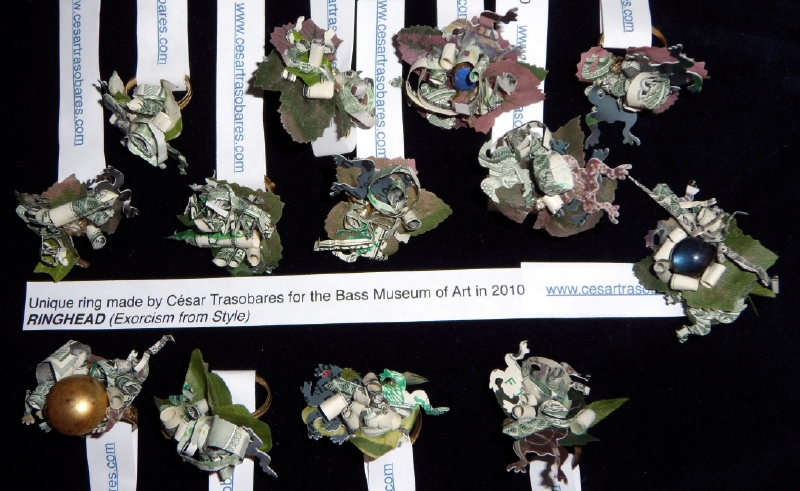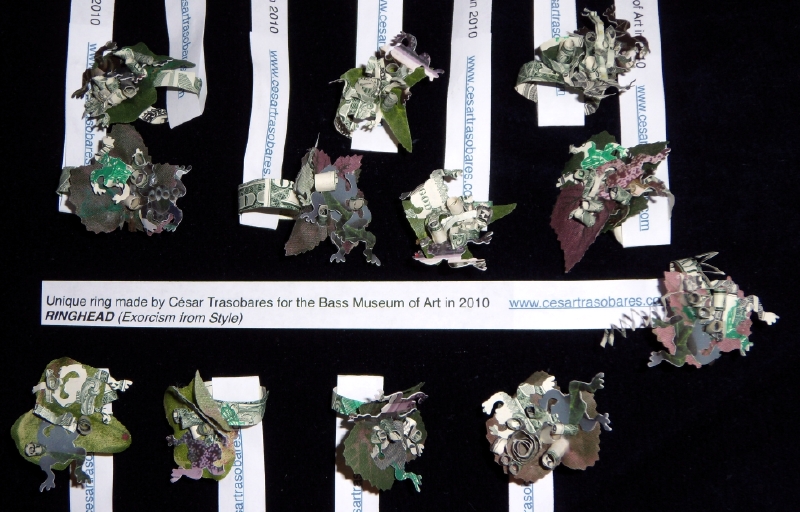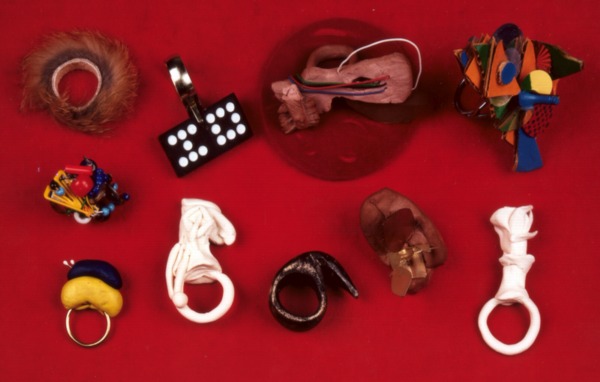RINGHEAD (Exorcism from Style)
originally in HUMAN RITES exhibition
Bass Museum of Art, Miami Beach,
currently on an extended loan to the Museum
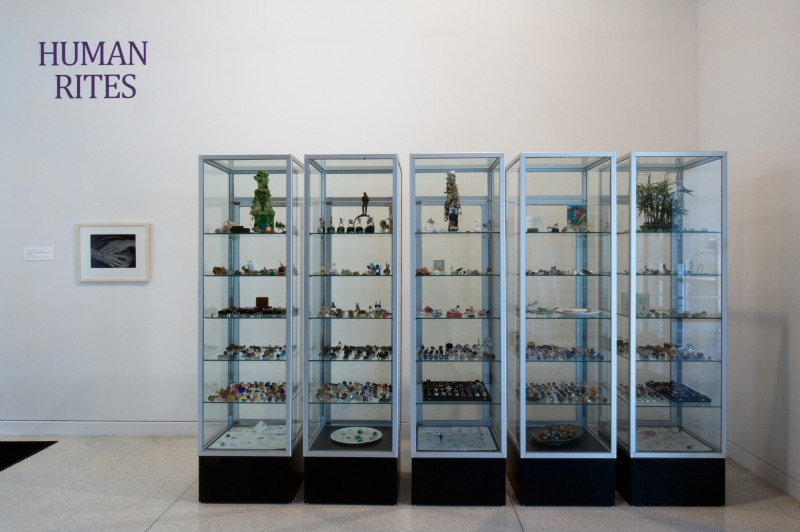
RINGHEAD (Exorcism from Style), 1983-present
by César Trasobares
My work with finger rings emerged as a form of private art.
Having completed ambitious esthetic projects in my first decade
as an artist1, I was looking for a small-scale format that would
allow for maximum flexibility, both conceptually and materially. I
had observed and studied finger rings since high school and was
fascinated how this basic format (hoop, shoulders and bezel) could
embody such varied content across many cultures
throughout history2.
In 1983 I began to carve rings in wood and horn in the shape of
eyes. I also started to experiment with different materials,
eventually focusing on making rings in the style of specific artists
or as fanciful miniature assemblages. In many ways, the
exploration of mutating forms served to liberate my imagination
by eliminating any self-imposed constraints in
conceiving and fabricating rings.
Some of the early rings were made with materials and in formats
that continued earlier work. I deployed small plastic ‘bachelor’
figures, which I had used in some of the Quinceañera boxes, along
with familiar materials like Sculptclay. I began to work with an
oven-hardened molding medium available in many colors. I
recycled thrift store rings by mixing components. I also became
interested in metalwork and took classes at a jewelry school.
Eventually I learned to cast rings in silver by experimenting in the
studio I had set up to make the rings.
I set aside a room in my house and furnished it with working
tables, a jeweler’s bench and an area to hold the lost-wax casting
equipment. I added a sink, special lights and shelves to hold
completed rings, materials and rings in process. There was also a
corner with books and my sketchbooks and drawings. The studio
became a special place where I retreated from my busy world to
dream and fulfill my needs as an artist.
I drew forms and designs for rings constantly. The small sketches
explored the potential of the format and became a way of
pursuing this interest during my free time when I was not working
on actual rings. I kept sketchbooks and drew on cards and other
papers at hand. The drawings were sometimes related to rings I
had learned about through my growing library of books on rings,
which bolstered my interest in ring history, iconography and
folklore. Some were drawn during and after museum visits. Others
were based on rings I saw people wearing or
in forms I envisioned.
As I worked at all stages in the ring-making process I developed
an appreciation for the evolution of things in the mind and the
world. I was very aware of stages of imagination,
conceptualization, formation, reformation, solidification, and
disappearance. At the same time I pondered on how forms
emerge from an unknown territory and where, on the other end of
the spectrum, most things eventually disappear, get lost or simply
decay, as sketched in the following scheme:
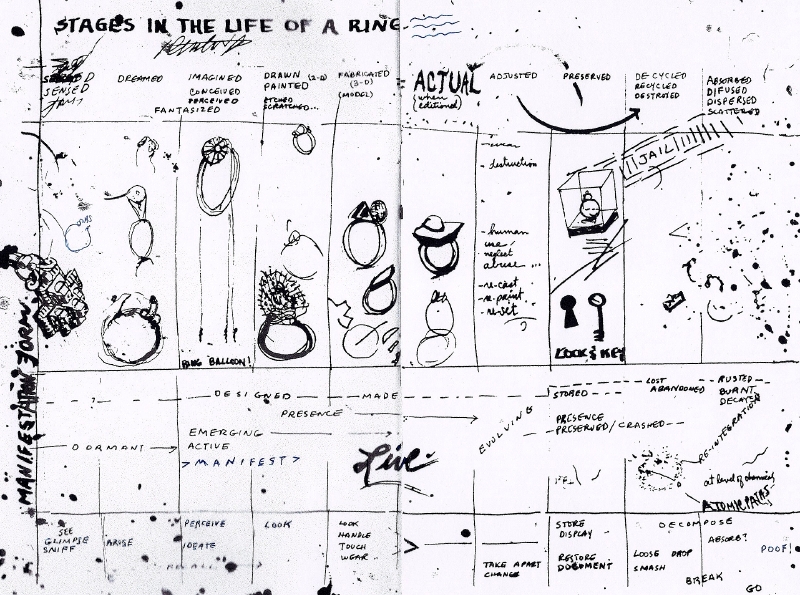
I reflected this spectrum in a landscape drawing, which I refined over
the years, adding insights (verbs) about the place of rings in a
vast ecologic/metaphoric panorama. In some ways, this diagram
alluded to the civilizing gesture of exchanging and gifting
meaningful objects among people and the uplifted values such
exchanges confer to things. In this context, the display case and
the function of collections and museums remain major factors in
preserving artifacts and works of art, establishing social value and
propagating individual and collective meanings.
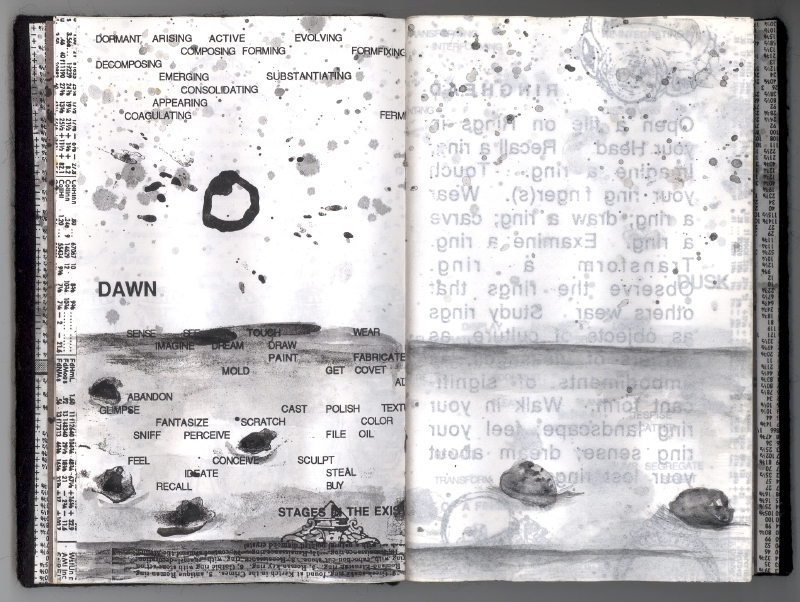
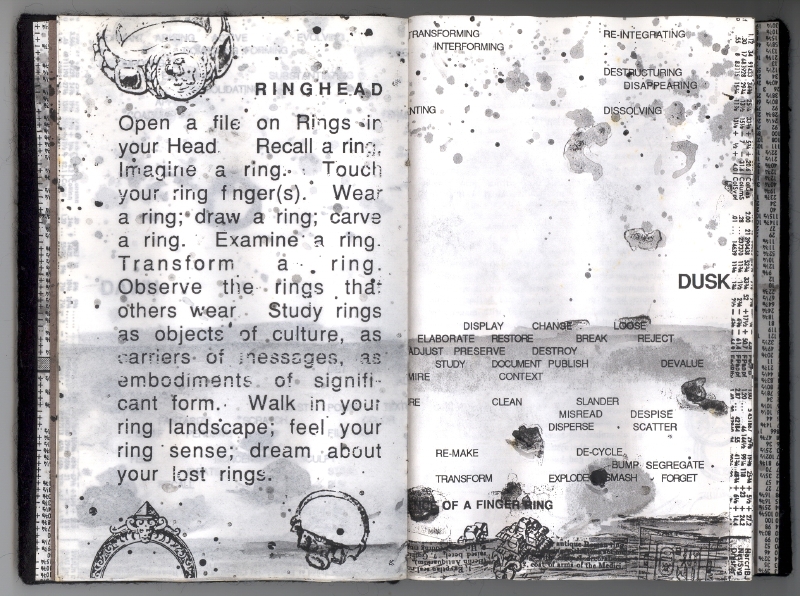
I also began to collect rings. I was curious about popular culture
rings, toy rings and rings from various societies, seeking these at
shops and flea markets. I went to recycling stores and usually
found interesting rings in boxes of trinkets and in jewelry boxes.
As I traveled I began to visit ethnographic and antique shops
continuing to acquire rings with the limited funds I had. I also
envisioned the growing collection as a dynamic arena of exchange
among people (who did not know one another) and
across time and geography.
Because I envisioned the ring-making activity as a type of private
art, I was not interested in selling or showing my work, mainly
because I believed I was making experimental sculpture, not
jewelry (much less Haute Joaillerie) or objects intended to be
worn. I struggled with this viewpoint over the years but my
resistance to turn the project into a moneymaking enterprise
prevailed. I stopped privileging individual objects and developed
an appreciation for the critical mass of the growing collection of
rings, especially how it reflected an uncharted field of collective
intelligence. I also started asking people about the rings they were
wearing: where they came from, what they were made of, which
meaning(s) they had. Through this process I learned that many
people would liven up and offer their viewpoints on the rings they
are wearing with a combination of amusement and pride.
By 1986-87, in an attempt to adopt a more universal viewpoint
and persona3, I developed a fictional character, Man Ring4. At the
time I served as an art administrator working with numerous
artists and wanted to separate my private art from my real-world
public esthetic and bureaucratic obligations.
Man Ring became a quasi-independent entity making rings and
drawings in silence. Occasionally I would detach myself from the
character to portray him and his world in drawings like “Man Ring
on the Edge of the Streams” and in format studies for books
about him and his research and adventures.
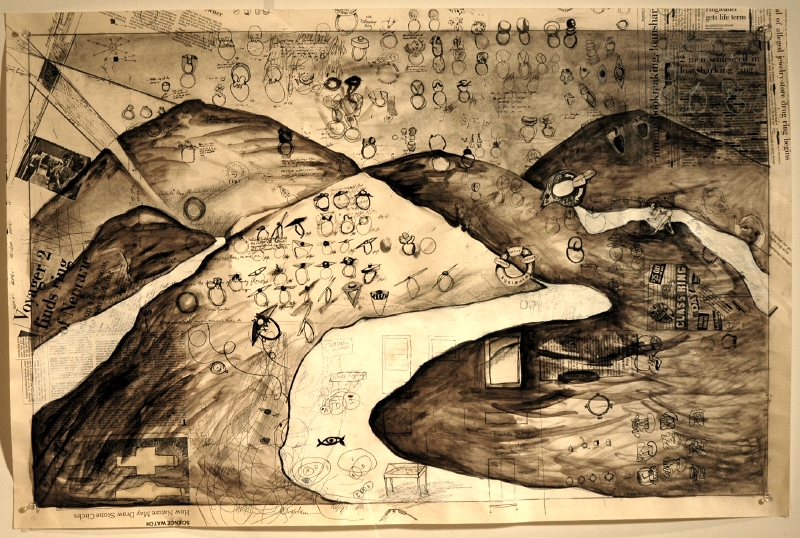
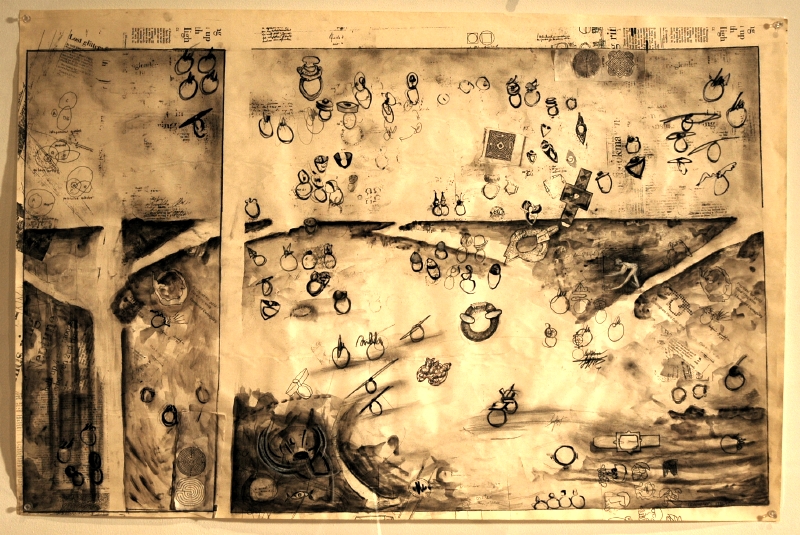
These overlapping activities went on through the years,
accumulating hundreds of rings in the process and beginning to
have small exhibitions of rings. Through my reading I had become
aware of magical, historic and other symbolic meanings conferred
upon rings and how individuals view, use and value rings
according to their background, education and interests. By early
1990 Man Ring had faded away as a separate entity as I had
consolidated the various roles I had adopted and integrated these
into my worldview. I had also decided to return to
my self-employed mode.
One important aspect of my work was a questioning of authorship
and prevalent ideas about artistic style. By refusing to work in any
specific esthetic direction, I refuted the social expectation of
singularity of expression or ‘signature style’ often adopted by
artists. The notion that an artist’s ‘hand’ or ‘style’ had to be
consistent felt very restraining to me. Through my work with
rings, including making rings with the forms of modernist ‘isms,’ I
found boundless freedom and confirmed my ability to work with
any material I wished. This territory without boundaries provided
the creative atmosphere I was seeking and served as
my self-administered exorcism from style.
Through my work I hoped to eventually address audiences to
awaken in them a spirit of creativity, curiosity and wonderment. In
some ways I expected viewers to realize they had artistic impulses
as artists do. I wished that everyone would accept the vast scope
of expression that could be considered beautiful, legitimate or
esthetically valid. I was probing to broaden the playing field
beyond the established realms of high and low culture,
insider and outsider art, academic and popular expression,
ordered civilization and entropic nature.
I began to see the rich variety of forms in the ring collection as a
model for flattening hierarchies of cultural valuation while
celebrating the properties of individual objects. Because each ring
is unique, with its own characteristics, colors, weight, content and
meaning it asserts its independent existence and relative worth.
Its relation to other rings is actual, based on specific formats,
although in the larger context, comparisons become technical
exercises, still valid, but not leading to acknowledging the singular
power of each ring, whatever its form and content, in spite of,
against or aligned with established canons and conventions.
The ring collection is a grouping with a totally open structure that
allows for broad interpretations. Hoping to emphasize the
uniqueness of each ring, viewers are encouraged to pose an initial
set of questions: who made it?; when?; for what purpose?; why
these materials?; who would wear it?; what is its relation to other
cultural trends or objects?; where in the world was it made or
worn?; what does it say about the human
character and condition?
I wanted to offer initial answers to some of these questions for
viewers, mostly to generate other questions and set a tone for the
exploration of the culture of rings. After several models of formats
for books, I produced the first draft of RINGHEAD in 1991,
combining a text I had developed about ring-lore with drawings,
images of rings and a sketchy bibliography. I intended to elaborate
and complete the book for printing, but this did not happen. Two
decades later I decided to publish RINGHEAD DRAFT, first as an
electronic book in my web archive and
eventually as an actual object.
Over the years I set up more display cabinets in my studio and
casually showed the ring collection to visitors while continuing to
work on rings and drawings. I often made notes on specific rings
in an attempt to catalogue and document the collection. I began
to pursue other projects in 1992, but never abandoned the
responsibilities of the ring-maker.
The installation RINGHEAD at the Bass Museum as part of the
exhibition Human Rites is the first formal showing of a
comprehensive selection from the ring collection. An earlier
installation featuring rings made from dollar bills,
CONSERVATORIUM, was commissioned by The Wolfsonian-FIU for
their bridge-tender house in 2005. As part of this project I agreed
to produce a series of perishable rings for sale
at the museum store.
The RINGHEAD project at the Bass Museum is also intended to
have documentary and educational components. I’m working with
museum staff and interns in producing a sequence of short videos
of people talking about a ring they may be wearing. I would also
like to conduct a workshop with Dade County Schools art teachers
on making elemental rings with their students and lead
conversations on ring history and literacy.
I produced a group of unique rings for the Museum Shop:
